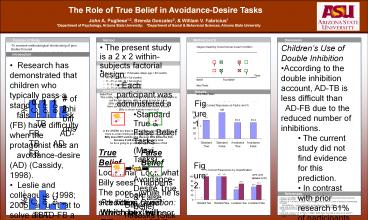The Role of True Belief in AvoidanceDesire Tasks PowerPoint PPT Presentation
1 / 1
Title: The Role of True Belief in AvoidanceDesire Tasks
1
The Role of True Belief in
Avoidance-Desire Tasks John A. Pugliese1,2,
Brenda Gonzalez2, William V. Fabricius1 1Departm
ent of Psychology, Arizona State University
2Department of Social Behavioral Sciences,
Arizona State University
Method Contd
Discussion
Purpose of Study
Method
- Childrens Use of Double Inhibition
- According to the double inhibition account, AD-TB
is less difficult than - AD-FB due to the reduced number of inhibitions.
- The current study did not find evidence for this
prediction. - In contrast with prior research 61 of
participants passed both the - AD-FB and AD-TB task.
- Although more children did pass the AD-FB task
than Leslie and - colleagues (1998 2005) found, this was most
likely due to the - inclusion of older children.
- In addition, the double inhibition account
predicts that a standard FB task - is equally difficult as the AD-TB task due to
both requiring only one - inhibition.
- The current study did not find evidence for this
prediction. - 71 of children passed the standard true belief
task. - The result suggests that 29 percent of the
children in the current - sample may be using Perceptual Access
reasoning (PA). - Childrens Use of Perceptual Access Belief
Reasoning - The PA account suggests that children have
difficulty with standard true - belief tasks.
- The present study is a 2 x 2 within-subjects
factorial design - Each participant was administered a
- Standard True False Belief Tasks (Maxi Tasks)
- Avoidance-Desire True False Belief Tasks (Sick
Kitten Tasks) - All tasks were counterbalanced
- To examine methodological shortcoming of prior
studies focused - on childrens understanding of belief and
desire.
Diagram Depicting Correct Answer to each
Condition
False Belief
True Belief Maxi Tasks Sick Kitten
Tasks Note X represents object final location,
and arrows indicate correct response.
Introduction
- Research has demonstrated that children who
typically pass a standard - false belief task (FB) have difficulty when
the protagonist has an - avoidance-desire (AD) (Cassidy, 1998).
- Leslie and colleagues (1998 2005) argue that
to solve an AD-FB a - child must double inhibit, increasing the
difficulty of the task. - The double inhibition account also predicts that
a FB and AD true belief task (TB) are equally
difficult for children, and require only a single
inhibition. - Leslie Colleagues Predictions (for children who
pass FB) - Problem with Leslies TB tasks the character
never leaves the scene,
Participants
- N 31, 16 males / 15 females, Mean age 66
months - 10 - 4½ yr olds (M 54 months)
- 11 - 5½ yr olds (M 64 months)
- 8 - 6½ yr olds (M 76 months)
- 2 - 7½ yr olds (M 90 months)
- Inclusion criteria for children Must pass the
standard False Belief Task .
Avoidance Desire Belief Tasks
Results
of inhibitions
This is Billy, he has some food, and its a piece
of fish. Billy wants to put the fish in a box.
Billy is going to look for a box. Billy goes
inside other room, leaving the fish behind Here
are two boxes. Lets look and see what is in
them. Billy is shown looking in each
box In the GREEN box there is a ball of
string. And in the RED box, there is a ball of
string and there is also a poor, sick
kitten.. Billy does NOT want to give the poor
little kitten the fish because it will make its
tummy very sore So he is going to go outside to
get the piece of fish
1
0
1
Figure 1.
2
Correct
TB FB AD-TB AD-FB
False Belief Look what happens while he is
gone! The poor sick kitten crawls out of the
boxand goes into the GREEN box. Did Billy
see that? -- No!
True Belief Look what Billy sees! The poor sick
kitten crawls out of the boxand goes into the
GREEN box. Did Billy see that? --
Yes! Billy goes outside to get the fish.
Figure 2.
Look Billy has the fish.
References
Prediction Question Which box will Billy go to
with the fish?
Cassidy, K.W. (1998). Three and four year old
childrens ability to use desire-belief based
reasoning. Cognition, 66, B1-B11. Fabricius, W.
V. Kahlil, S. (2003). False beliefs or false
positives? Limits on children's understanding of
mental representations. Journal of
Cognition and Development, 4, 239 262. Leslie,
A.M. Polizzi, P. (1998). Inhibitory processing
in false belief tasks Two conjectures.
Developmental Science, 12, 247- 253.
Leslie, A.M., German, T.P. Polizzi, P. (2005).
Belief-desire reasoning as a process of
selection. Cognitive Psychology, 50, 45-85.
Correct
TBT FBT AD-TB AD-FB

